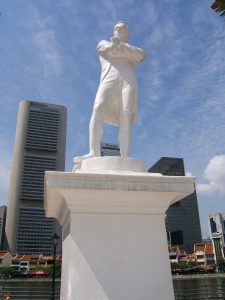Commemorating Raffles: The creation of an imperial icon in colonial Singapore
February 6, 2023

Associate Professor Timothy Barnard (NUS History) considers the changing popular imagination of Singapore’s colonial founder, Stamford Raffles, from his relative obscurity post-death to the unrivalled heights that he now occupies in ‘Commemorating Raffles: The creation of an imperial icon in colonial Singapore’ (Journal of Southeast Asian Studies, 2019).
A/P Barnard contextualises Raffles within the backdrop of several exceptional individuals such as William Marsden, John Crawfurd, and William Farquhar, who might themselves have ended up the iconic representative of Britain’s imperial legacy within Southeast Asia. The reason given for Raffles ascendency, however, was that Marsden and Crawfurd both returned to England, somewhat cutting short their Southeast Asian legacies, and that Farquhar was involved in disputes with Raffles himself.
Sophia Raffles, the widow of Stamford Raffles, played a crucial role in his rehabilitation through publishing memoirs of his life and challenging the otherwise more negative characterisations of him as an arrogant and largely ordinary man. A/P Barnard presents an intriguing account of Raffles, as a man little thought of by those back in London, and mostly forgotten until Victorian Britain’s shift to a more strident and triumphant form of colonialism. A shift to a ‘great pantheon of heroes’ within British imperialism that needed symbolic figures such as Clive of India, Rhodes of Africa, and most importantly for Southeast Asia, Raffles of Singapore.
The creation of the imperial icon of Stamford Raffles started in earnest from the 1850s with what was once known as Commercial Square renamed to Raffles Place in 1858, and the Singapore Institution, the oldest but not necessarily best high school, being renamed the Raffles Institution in 1867.
Raffles Place occupies both the colonial and contemporary imaginary as a place of free trade that is unquestionably associated with its namesake. As for the Raffles Institution, by 1903 it had developed into a primary school for the elite, and continues on into the present era to represent quality, tradition, and arguably, elitism.
Although there were attempts to de-colonise and de-imperialise Singapore’s legacy during the 1960s and 70s, with provocative acts such as splattering statues of Raffles with white paint in August 1970, and government discussions to take down commemorations of British figures such as Raffles, the decision was ultimately made to accept the past for what it was versus the hopes of what it might have been. Stamford Raffles quietly looms on in the background of modern Singapore.
Read the full article here.
